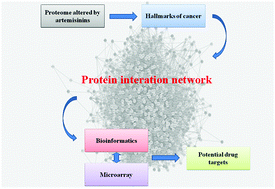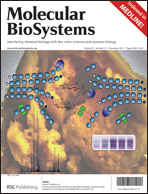Artemisinin rewires the protein interaction network in cancer cells: network analysis, pathway identification, and target prediction†
Abstract
Artemisinin and related compounds (artemisinins), as a frontline treatment for malaria, have been used to save millions of lives. Their potential application in cancer treatment is promising. Nevertheless, the precise mechanisms of action of artemisinins are still controversial. In particular, the system-level influence of artemisinins on protein interactions and regulatory networks remains unknown, limiting progress in development of this class of compounds as anticancer drugs. In the present study, we investigated the mechanism of action of artemisinins in cancer therapy through an analysis based on biological networks. According to experimental evidence from more than 400 literature studies, 558 key proteins were derived and the artemisinins-rewired protein interaction network was constructed. Topological properties were analyzed to show that the protein network was a scale-free biological system. And the modularity analysis and pathway identification were performed. Five key pathways including PI3K-Akt, T cell receptor, Toll-like receptor, TGF-beta and insulin signaling pathways were involved in artemisinins-mediated anticancer effects; their identification was confirmed by microarray data. Based on these results, predictions were made about the targets of artemisinins in various pathways. These results provide a deeper understanding of the molecular mechanisms of action of artemisinins and will contribute to the development and application of this class of compounds in cancer treatment.


 Please wait while we load your content...
Please wait while we load your content...